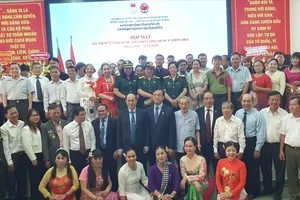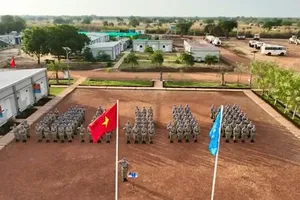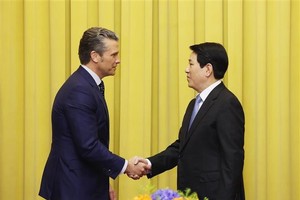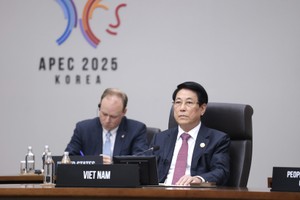KAMAISHI, Japan (AFP) – Workers struggled Sunday to restore power to a nuclear plant's overheating reactors as the toll of dead or missing from Japan's worst natural disaster in nearly a century surpassed 20,000.
The discovery of radiation in foodstuffs in regions around the plant, and of traces of radioactive iodine in Tokyo tap water well to the southwest, compounded public anxiety but authorities said there was no danger to health.
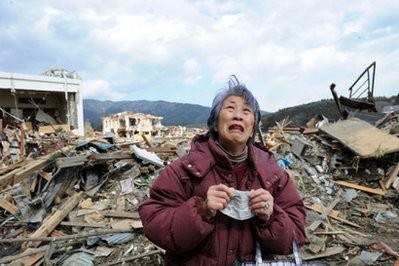
The Fukushima No. 1 plant was struck on March 11 by a massive earthquake and tsunami which, with 8,133 people confirmed killed, is Japan's deadliest natural disaster since the Great Kanto quake levelled much of Tokyo in 1923.
Another 12,272 are missing, feared lost to the tsunami or buried in the wreckage of buildings. For half a million survivors, many huddled in poorly supplied and spartan shelters, conditions in the icy north are miserable.
In Miyagi prefecture on the devastated northeast coast, where the 10-metre (33-foot) tsunami reduced entire towns to splintered matchwood, the death toll stood at 4,882.
But Miyagi police chief Naoto Takeuchi told a task force meeting that his prefecture alone "will need to secure facilities to keep the bodies of more than 15,000 people", Jiji Press reported.
According to the charity Save the Children, around 100,000 children were displaced by the disaster, and signs of trauma are evident among survivors as the nuclear emergency and countless aftershocks heighten their terror.
"We found children in desperate conditions, huddling around kerosene lamps and wrapped in blankets," Save the Children spokesman Ian Woolverton said after visiting a number of evacuation centres in Japan's tsunami-hit northeast.
"They told me about their anxieties, especially their fears about radiation," Woolverton said, adding that several youngsters had mentioned the US atom bomb attacks on Hiroshima and Nagasaki, which they know from school.
Cooling systems that are meant to protect the Fukushima plant's six reactors from a potentially disastrous meltdown were knocked out by the tsunami, and engineers have been battling ever since to put a lid on rising temperatures.
The radiation-suited crews were striving to partially restore electricity to the ageing facility 250 kilometres (155 miles) northeast of Tokyo, after extending a high-voltage cable into the site from the national grid.
But plant operator TEPCO said it would be hard by the end of Sunday to restart power to the cooling systems on two reactors that were badly damaged when a series of explosions tore away their outer buildings.
Spraying of water from high-pressure hoses -- an operation meant to cool the reactors from afar -- was complicating the reconnection of electricity, it said, according to Jiji Press.
Fire engines again aimed their water jets at the reactors and fuel rod pools, where overheating is an equal concern, dumping in thousands of tonnes of seawater from the adjoining Pacific.
"When I told her that I was going to Fukushima, my wife replied, 'I wish you would be a saviour of Japan'," said Yasuo Sato, commander of the Tokyo Fire Department's Hyper Rescue Unit, which sent dozens of firefighters to join the dousing efforts.
Six workers at the Fukushima plant have been exposed to high levels of radiation but are continuing to work and have suffered no health problems, TEPCO said.
Japan's government has been insisting that there is no widespread threat of radiation but confirmed Saturday that tainted milk had been found in Fukushima prefecture, and contaminated spinach in neighbouring Ibaraki.
Abnormal levels of radioactive iodine were also found in the water supply in areas including Tokyo and Fukushima, officials said. But as with the milk and spinach, they stressed the levels were still far too low to endanger health.
In the disaster epicentre of northeast Japan, authorities have been battling to get more fuel and food to sick and hungry survivors enduring freezing temperatures.
At shelters, some grandparents are telling children stories of how they overcame hardships in their own childhood during and after World War II, which left Japan in ruins.
"We have to live at whatever cost," said Shigenori Kikuta, 72.
"We have to tell our young people to remember this and pass on our story to future generations, for when they become parents themselves," he said.
There was better news for residents in Rikuzentakata where construction teams began erecting 36 prefabricated units, the first of many more temporary houses being built for the tsunami homeless.
"They won't be very big, but whatever they are, it will be better than being in here," said great-grandmother Tokiko Kanno, who has been sleeping on a school stage.

